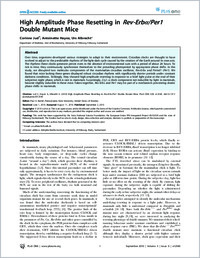High amplitude phase resetting in Rev-Erba/Per1 double mutant mice
- Jud, Corinne Department of Medicine, Unit of Biochemistry, University of Fribourg, Fribourg, Switzerland - Adolphe Merkle Institute, University of Fribourg, Switzerland
- Hayoz, Antoinette Department of Medicine, Unit of Biochemistry, University of Fribourg, Fribourg, Switzerland
- Albrecht, Urs Department of Medicine, Unit of Biochemistry, University of Fribourg, Fribourg, Switzerland
-
09.02.2010
Published in:
- PLoS ONE. - 2010, vol. 5, no. 9, p. e12540
English
Over time, organisms developed various strategies to adapt to their environment. Circadian clocks are thought to have evolved to adjust to the predictable rhythms of the light-dark cycle caused by the rotation of the Earth around its own axis. The rhythms these clocks generate persist even in the absence of environmental cues with a period of about 24 hours. To tick in time, they continuously synchronize themselves to the prevailing photoperiod by appropriate phase shifts. In this study, we disrupted two molecular components of the mammalian circadian oscillator, Rev-Erbα and Period1 (Per1). We found that mice lacking these genes displayed robust circadian rhythms with significantly shorter periods under constant darkness conditions. Strikingly, they showed high amplitude resetting in response to a brief light pulse at the end of their subjective night phase, which is rare in mammals. Surprisingly, Cry1, a clock component not inducible by light in mammals, became slightly inducible in these mice. Taken together, Rev-Erbα and Per1 may be part of a mechanism preventing drastic phase shifts in mammals.
- Faculty
- Faculté des sciences et de médecine
- Department
- Département de Biologie, AMI - Bio-Nanomatériaux
- Language
-
- English
- Classification
- Biological sciences
- License
- License undefined
- Identifiers
-
- RERO DOC 20442
- DOI 10.1371/journal.pone.0012540
- Persistent URL
- https://folia.unifr.ch/unifr/documents/301847
Statistics
Document views: 99
File downloads:
- alb_hap.pdf: 118
